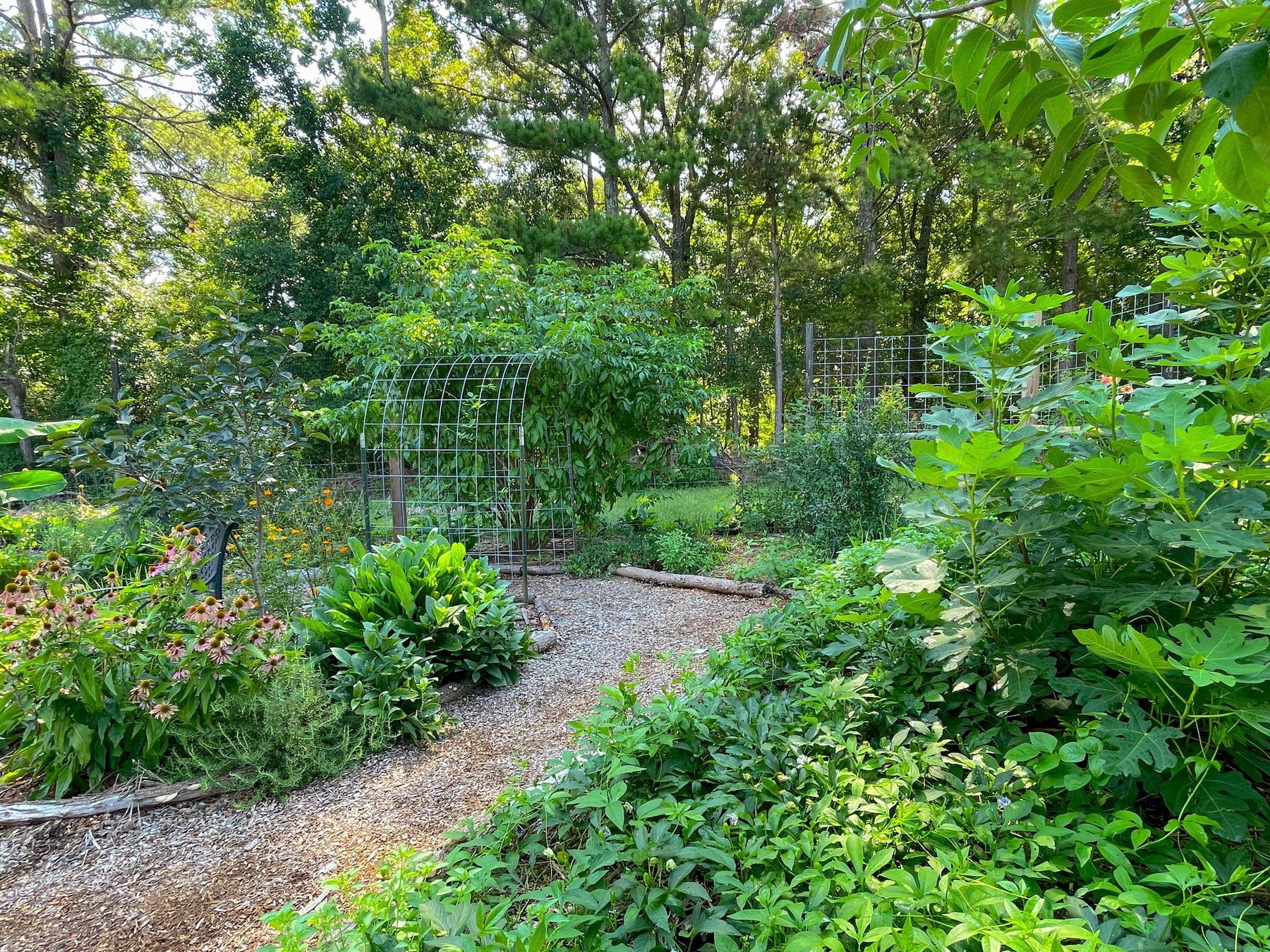
Food Forests: Seven Layers of Delicious, Low-Maintenance Chaos
Imagine stepping into a lush, abundant landscape where fruit trees tower above, vines weave through the branches, and herbs flourish at your feet. Every inch of soil is alive, every plant serves a purpose, and together, they form a self-sustaining ecosystem—one that mimics the natural forests that have fed and sheltered life for millennia. This is a food forest, a regenerative way of growing food that not only nourishes people but also restores the land, supports biodiversity, and strengthens the connection between humans and Nature.
Unlike traditional gardens that require constant input and maintenance, a permaculture food forest is designed to work with Nature, not against it. To a traditional gardener, this may look like chaos; but to Nature, this is the intended way of growing things. It’s an intentional, layered planting system where every plant plays a role—providing food, medicine, wildlife habitat, soil fertility, or microclimate benefits. Rooted in indigenous agriculture, regenerative gardening, and permaculture design, food forests honor the intelligence of the land, allowing us to grow an abundance of organic fruits, nuts, and medicinal plants while regenerating the earth.
The Seven Layers of a Food Forest
A thriving edible forest garden is designed with seven interwoven layers, each offering unique benefits. Let’s walk through them, from the towering trees to the hidden life beneath the soil. Here in Georgia, we are in a temperate climate and examples of each layer will reflect what will grow here.
1. The Canopy Layer (Overstory Trees)
The canopy consists of the tallest trees (typically 30ft and above), forming the backbone of the food forest. These trees provide shade, shelter, and a framework for vines to climb while creating a microclimate that protects more delicate plants below. They are often large, long-lived species that anchor the system with stability and abundance.
Examples:
2. The Sub-Canopy (Small Fruit and Nut Trees)
Beneath the towering canopy, the sub-canopy trees thrive. These are medium-sized trees, 10ft to 30ft tall, that provide additional layers of fruit, nuts, or medicinal properties while supporting the overall diversity of the system.
Examples:
- Apples
- Figs
- Pawpaws
- Mulberries
3. The Shrub Layer
The shrub layer brings berries, nitrogen-fixing plants, and medicinal plants into the system. These smaller woody plants flourish in dappled sunlight and provide food for both humans and wildlife.
Examples:
4. The Herbaceous Layer (Perennials & Herbs)
This layer includes a mix of perennial vegetables, culinary herbs and medicinal herbs, and pollinator-friendly plants. This layer includes a mix of perennial vegetables, culinary herbs, and medicinal plants, many of which repel pests, attract pollinators, and improve soil health.
Examples:
- Comfrey – soil builder & mulch producer
-
Yarrow – pollinator attractor & medicinal
- Echinacea – immune-supporting & pollinator-friendly
5. The Ground Cover Layer
This low-growing layer acts as a living mulch, helping to retain moisture, suppress weeds, and prevent soil erosion. Some even produce fruit!
Examples:
6. The Root Layer (Underground Crops & Soil Builders)
Beneath the surface, a world of roots, tubers, and fungi thrives, supporting soil health and providing nutrient-dense food. Deep-rooted plants help break up compacted soil and cycle nutrients back into the system.
Examples:
- Yacon
- Egyptian Walking Onions
- Turmeric
- Taro root
7. The Vertical Layer (Vining Plants & Climbers)
The final layer reaches for the sky—vining plants that weave through the trees, utilizing vertical space while producing food and adding beauty. Many vines also act as nitrogen fixers or provide pollinator benefits.
Examples:
- Passionflower – edible fruit & medicinal
- Grapes
- Hardy kiwi
- Hops
Why Create a Food Forest?
A food forest isn’t just about growing food—it’s about restoring relationships. It reconnects us with the rhythms of Nature, offering a way to grow that is both productive and regenerative. It’s a living, breathing testament to self-sufficiency, sustainability, and resilience—principles that guide our work in helping others nourish themselves, their loved ones, and the land.
When we plant a food forest, we’re not just growing food; we’re creating an ecosystem that will outlive us, feeding generations to come. Here at the nursery, we plant trees we hope our grandchildren will see their grandchildren harvest from. The beauty of this approach is that once established, a food forest requires less maintenance than a traditional garden, as the plants work together to maintain balance.
Bringing a Food Forest to Life
If you’re feeling inspired to start your own food forest, begin by observing your land—where does the sunlight fall? How does the water move? What native and edible plants already thrive there? Start small, introduce layers over time, and let Nature be your guide.
If you need help designing or selecting plants for your food forest, I’d love to support you on this journey. Whether through in-person workshops, consultations, or by supplying resilient, sustainably grown edible, medicinal, and native plants, my goal is to help you cultivate abundance in harmony with the land.
Let’s rewild our landscapes, reclaim our connection to the earth, and plant a future rooted in resilience.

Leave a comment